Rafting in the Grand Caynon Lees Ferry to Pipe Creek with OARS.
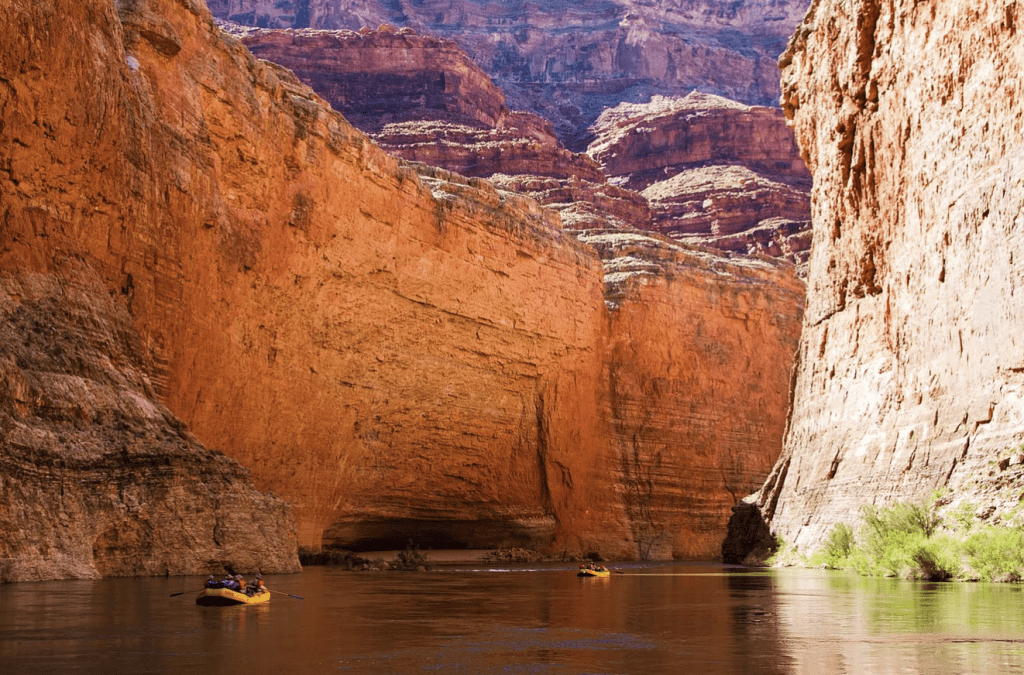
This 88-mile section of the Colorado River is an excellent introduction to the Grand Canyon as the rapids progress from moderate to extra large, and the cliffs and rock layers rise higher and higher. We see some of the most striking and vibrantly colored limestone cliffs as we pass Marble Canyon. Our Grand Canyon adventure includes visits to Native American ruins, the fern-fringed spring of Vasey’s Paradise, the cool recess of Redwall Cavern, ancient fossils and a swim in the turquoise blue Little Colorado. At the end of the week of floating, hiking and camping in the Grand Canyon’s majesty, this trip concludes with a dramatic long hike up to the South Rim.
HIGHLIGHTS
- Raft the first 88 miles of the Colorado River through the Grand Canyon
- Explore Redwall Cavern & Nautiloid Canyon
- Hike to Nankoweap & explore Native American ruins
- Raft 19 major rapids like Unkar, Hance, Sockdolager & Grapevine
- Our Grand Canyon rafting trip concludes with a strenuous hike up the Bright Angel Trail, ascending almost 4500 feet in elevation.
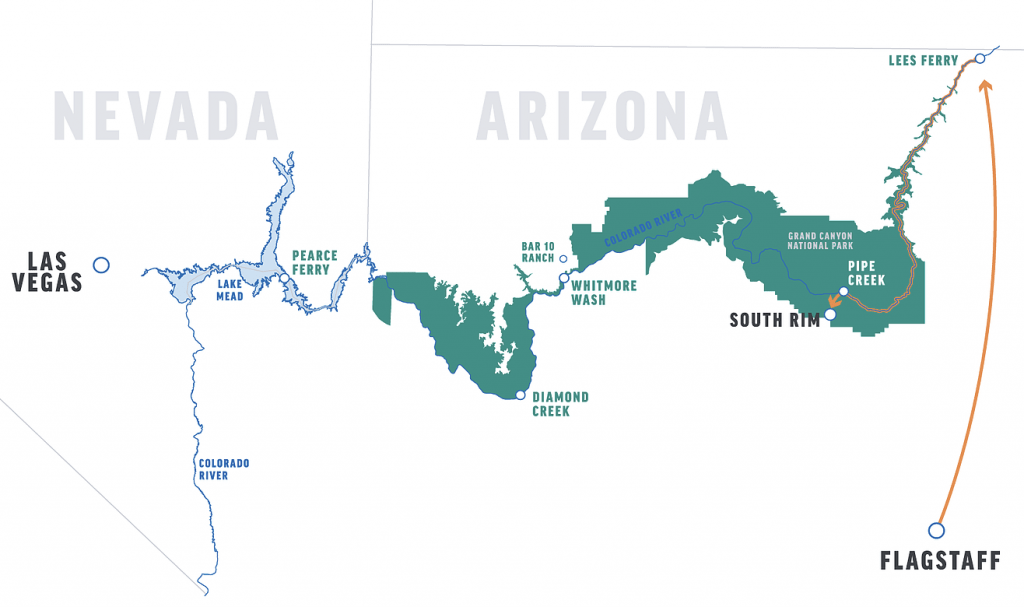
ITINERARY & MAP
- A shuttle from our meeting point in Flagstaff, AZ to our put-in below Glen Canyon Dam at Lees Ferry
- We enter Marble Canyon, and within the first few miles of the trip we see the first signs of the fascinating geology of the canyon as the Kaibab and Toroweap formations make their appearance, followed by Coconino Sandstone.
- Raft Badger and Soap Creek rapids before stopping to camp at a sandy beach
- The first signs of Esplanade Sandstone appear in the canyon walls followed by the Wescogame, Manakacha and Watahomigi formations as we negotiate a series of 8 medium intensity rapids.
- As we float deeper into the canyon past Vasey’s Paradise, we reach Redwall Cavern, a vast chamber in the canyon wall that Powell inaccurately estimated would seat 50,000 people.
- Deeper still, we raft through Mile 36 Rapid and Mauv Limestone appears in the canyon walls followed by Temple Butte Limestone and Bright Angel Shale.
- A hike to the ancient Native American granaries at Nankoweap rewards us with one of the best downriver views in the Grand Canyon.
- The canyon begins to spread out in front of us as we encounter Tanner, Unkar, Nevills and the formidable Hance Rapid.
- Black Vishnu Schist and pink Zoroaster Granite (some two billion years old) appear in the canyon walls.
- On the last day of the trip, make the arduous hike out of the canyon on the Bright Angel Trail to the South Rim.
- PLEASE NOTE: Starting in 2021 this trip requires backpacking your gear (20-30 lb.) from the river to the South Rim.
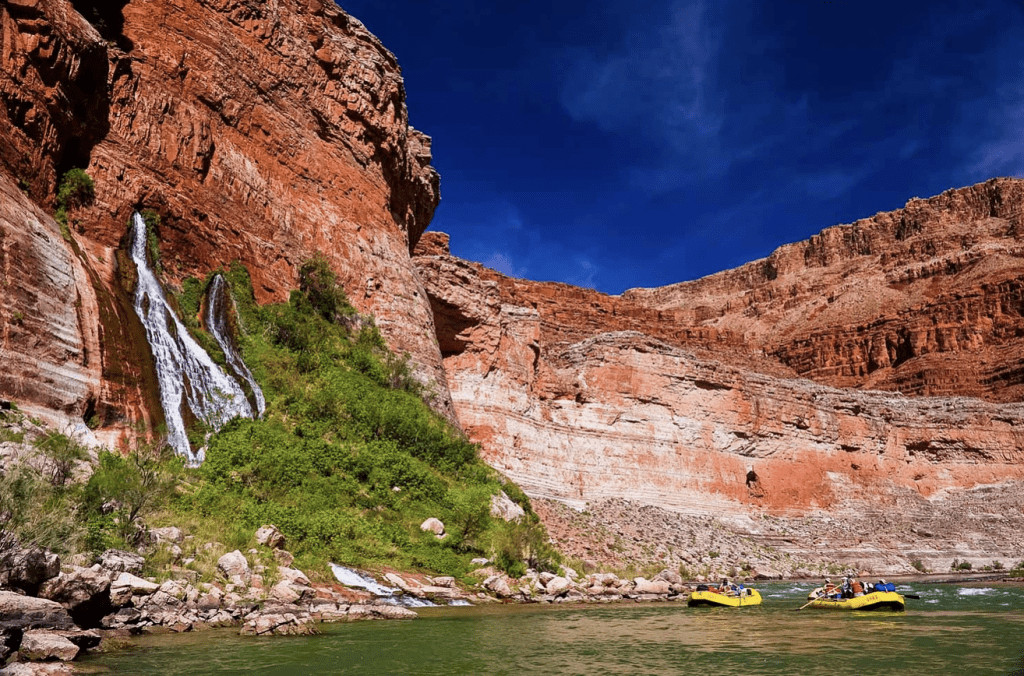
TRIP SNAPSHOT
MEETING PLACE:
DoubleTree by Hilton Hotel, 1175 W Route 66, Flagstaff, Arizona
MEETING TIME: 6:30 PM, the evening prior to your trip
RIVER RATING: 19 major rapids rated 5 or above on the Grand Canyon scale of 1 to 10
RIVER MILES: 88
PUT-IN: Lees Ferry
TAKE-OUT: Pipe Creek
TRIP LENGTH: 6 or 7 days
AGE LIMIT: Minimum age is 12 years old
WEIGHT LIMIT: 260 pounds.
BOAT TYPE: We raft the river in 18′ inflatable rafts that hold 4 passengers and a guide. The guide rows the dory with a long pair of oars.
This section of the river is an excellent introduction to the canyon. The rapids start out moderate and grow larger each day, allowing you to become familiar with the boat’s movement through the rapids. Even though the biggest rapids in the canyon are below Pipe Creek, this section has more fast-moving water overall. The cliffs and rock layers rise at an almost incomprehensible rate. Our adventure includes the vibrant-colored limestone cliffs of Marble Canyon, visits to Native American ruins, ancient fossils, Redwall Cavern and a visit to the Little Colorado. The trip ends at Pipe Creek where you begin backpacking out of the canyon.
Please Note: This trip requires backpacking your gear (20-30 lb.) from the river to the South Rim.
The following is a sample of what your trip might be like:
The Day Before Your Trip. . .
We’ll meet at 6:30 PM at the DoubleTree Hotel in Flagstaff for a pre-trip meeting. This is an opportunity to meet your fellow travelers and guides and ask any last-minute questions. Your guides will give you a thorough trip orientation, including a briefing on our updated COVID-19 policies and procedures. They will also pass out your waterproof river bags so you can pack your belongings that evening.
Your Trip Begins. . .
At 7:00 AM you’ll board our van at the DoubleTree Hotel. By this time, your waterproof bags should be packed, luggage stored, cars parked, breakfast eaten and room keys turned in. Our van will drive you to Lees Ferry (2½-hour drive) where we’ll load the boats, give a river safety talk and fit you with a personal flotation device (PFD) before putting on the river. Our apprehensions are quickly converted to exhilaration as we splash through Badger & Soap Creek Rapids. The desert’s warmth quickly dries us again before we reach camp. After a delicious dinner, we stretch out in our sleeping bags to drift off to sleep under a starry sky.
The Adventure Continues. . .
The river twists between rising cliffs, offering new vistas at every bend. At North Canyon, we walk across folded layers of sedimentary rock which leads to a pool trickling down from the polished funneled canyon. Our afternoon of lazy drifting is enlivened by the rapids of the “Roaring Twenties.”
The vibrant-colored walls of Marble Canyon tower overhead as we continue our float past the fern-fringed springs of Vasey’s Paradise for a stop at Redwall Cavern. This vast, half-circular chamber carved out by the river offers a cool recess to rest. A few miles downriver we scramble over short, steep rock formations into Nautiloid Canyon where we find a unique display of fossils exposed in the smooth rock canyon floor.
Relaxed drifting occupies much of the day interspersed by a few good rapids. A stop at Nankoweap Canyon gives us an opportunity to climb to the Ancestral Puebloan granaries that rest high on the cliff overlooking the Colorado River for a spectacular view of the river and vibrant canyon hues below. If we are lucky, the Little Colorado will be flowing with opaque turquoise (instead of muddy brown) water, which will invite us to stop for a swim. For a few miles, the canyon opens up before we head into the Granite Gorge. We then go through a series of challenging rapids. We’re drenched in turn by the big waves of Unkar, Nevills, Hance, Sockdolager and Grapevine rapids.
The Last Day of Your Trip
You’ll rise early so you can get an early start on the trail. Eat breakfast, prepare a sack lunch and finish packing your backpack. We’ll then head downstream to Pipe Creek, about a mile past Phantom Ranch, where you will start the hike out of the canyon. The hike to the rim generally takes six to nine hours.
Included in Your Trip Cost
- Skilled professional guide service
- All meals from lunch on day 1 to a sack lunch on your last day while hiking out of the canyon
- One waterproof bag to hold your gear for the trip (approximate sealed size: 20” tall x 14” diameter)
- One small waterproof bag for camera and film and other small items you’ll want during the day (approximate sealed size: 17” tall x 9” diameter)
- Sleep kit—consisting of a sleeping bag, deluxe 3-inch thick air-filled sleeping pad, ground tarp, sheet and pillow packed in a large waterproof bag, which will be given to you on your first evening in camp
- 2-person tents on a shared basis
- Personal flotation device (PFD) which must be worn at all times on the river in compliance with National Park Service regulations
- 12-ounce insulated Klean Kanteen with Café Lid to use for drinks in camp
- Camp chairs
- Eating utensils, cups and plates
- Highest quality rafts and related equipment
- Transportation by van from Flagstaff to put-in at Lees Ferry
Not Included in Your Trip Cost
- Transportation to Flagstaff and back from the South Rim
- Pre- and post-trip accommodations and meals
- Grand Canyon National Park Entrance Fee*
- Insurance of any kind, including a travel protection plan
- Alcoholic beverages
- Items of a personal nature (an equipment list provided below)
- Gratuities
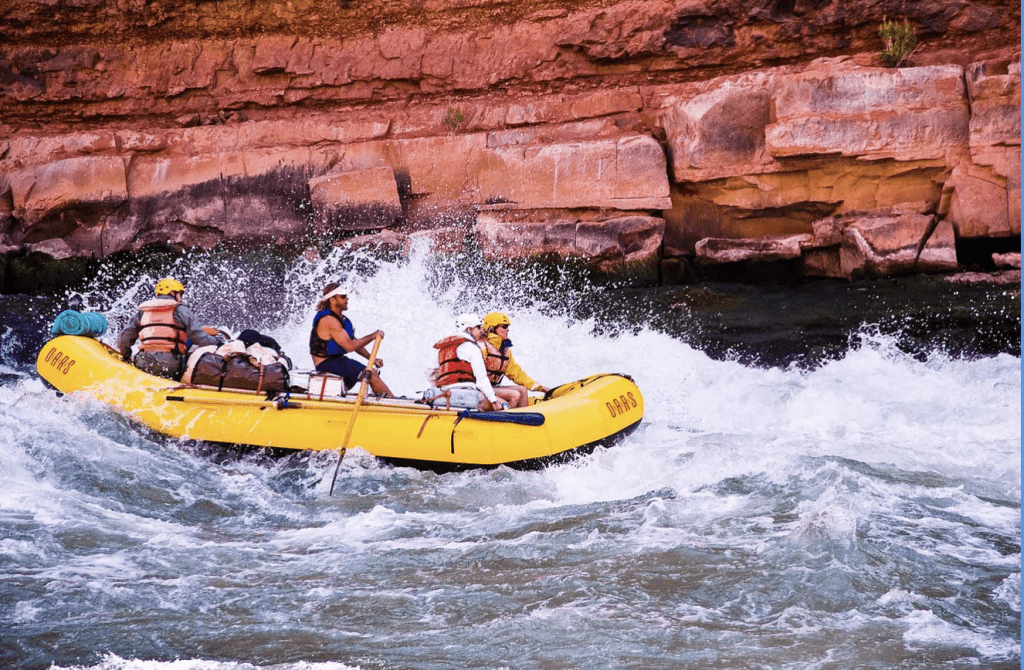
BOAT TYPE (see photos at http://www.oars.com/experience/boats/)
On our Grand Canyon trips, we use inflatable oar rafts, the most stable of whitewater craft, which is rowed from the center of the boat by your guide. Our rafts carry four passengers and a guide, plus gear. We travel in a flotilla with the maximum group size of 16-20 passengers.
WHITEWATER
There are 19 rapids rated 5 or higher on the Lees Ferry to Pipe Creek section. Whitewater in the Canyon is rated on a scale of 1–10 (unlike most western rivers which use the I–VI scale). A “1” is a small riffle, and a “10” is the most difficult rapid still considered runnable. Two of these, Unkar and Nevills produce consistent 6 (sometimes 7) whitewater. Hance, Sockdolager, and Grapevine rapids are always an 8 or 9. The intensity of all rapids naturally depends on the water level, so readings for low and high water levels may vary slightly. Based on various circumstances such as water levels and current flow, we on occasion find it necessary to have our passengers walk around certain rapids. The decision is made by the trip leader with the first concern being the safety of each passenger and secondly the ability to run a rapid without damaging the boats. This will give you a great opportunity to take some wonderful photos of the rafts as you watch your guides demonstrate their boating skills. When conditions warrant, you may also be asked by your trip leader to wear a helmet. For your own safety, however, you may feel more comfortable with wearing the helmet even more than specifically requested by the trip leader.
HIKES ALONG THE RIVER
Each day varies, but on average you’ll spend three to five hours on the boats. The rest of the time is spent hiking and exploring side canyons, eating or just relaxing in camp. The easiest hikes are no more difficult than negotiating a few yards of beach sand or stepping over a few rocks. Others may go for several miles over a rough trail, climb steeply up a hot hillside, require the use of both hands over awkward boulders and demand caution as you totter on a narrow trail above a steep cliff. Our guides are happy to help novices with hand and footholds and reassurance. Many times their helpfulness enables the timid and inexperienced to get to special places that many other groups pass by. Remember, however, all hikes are optional, and you can choose to relax and take in a few tanning rays or read a book instead.
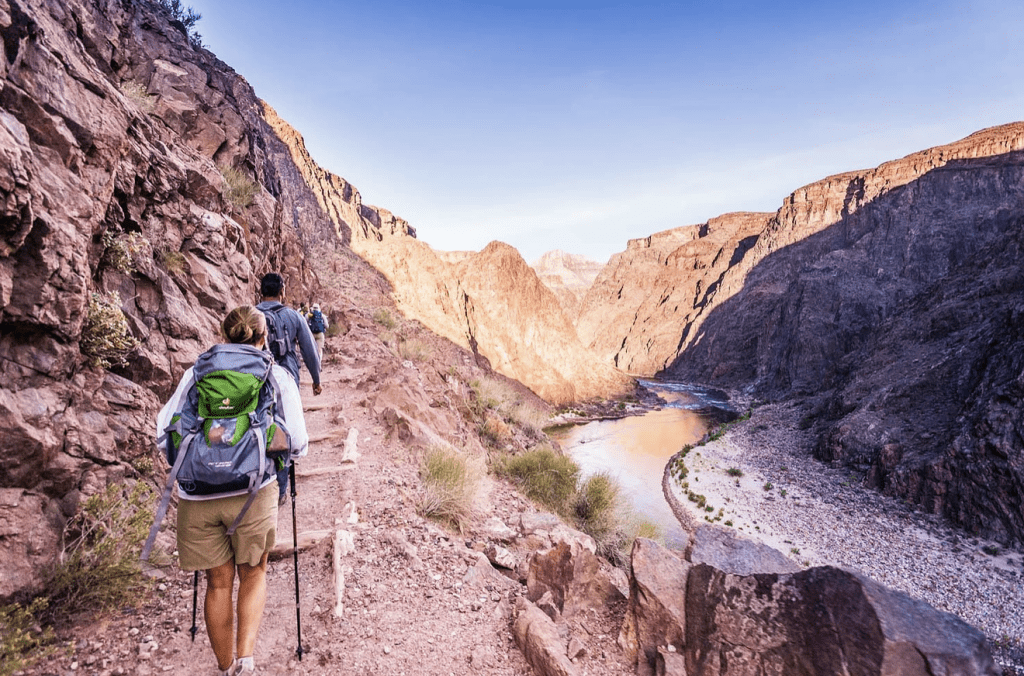
HIKING UP TO THE SOUTH RIM
The hike requires carrying your personal effects in a backpack, (which with careful packing, should weigh between 20-30 lb. when fully loaded) as you traverse the Bright Angel Trail between the river (Pipe Creek) and the South Rim. The hike is 7.7 miles, ascending about 4500 feet and may be one of the most physically demanding endeavors you will undertake in your life. It is essential you can comfortably complete the hike out carrying a weighted pack along with food and 2-3 liters of water (20-30 lb.). Temperatures on the trail can easily reach 110 degrees or more during the summer months. The combination of carrying a backpack, the potential for extreme heat and the elevation gain of almost one vertical mile makes this an incredibly challenging day. This hike can be exhausting for even the most physically fit and prepared hiker.
Be honest with yourself. If you are not already a backpacker or frequent hiker, this trip may not be right for you. You must be committed to doing additional training and conditioning before you begin your trip. It’s up to you to carry your backpack. An inability to successfully complete the hike endangers not only yourself but also the other guests and guides on the trip.
The Bright Angel Trail is a well-traveled, well-defined, maintained trail and offers some spectacular views of the Canyon. It is also patrolled by National Park Service rangers. Drinking water is available (subject to pipeline breaks) throughout the year at Indian Gardens. Water is available seasonally (May-September) at 3 mile and 1.5 mile rest houses from the rim.
As required by the National Park Service, we have a hike escort accompany our guests on the hike to the South Rim. Essentially you hike at your own pace, with the hike escort being the “sweep” person following the last hiker in the group. Our hike escorts are well-trained and have a great deal of experience hiking the Bright Angel Trail. She/he can give you great advice and hiking tips as you make your ascent to the rim.
Please Note: This hike should only be undertaken by those in very good physical condition. It is not recommended for anyone who is in poor general health, is elderly, has heart or lung disease, is overweight, or is not physically fit. If you have any of these conditions or are unsure whether you are in good enough shape for this hike, we strongly urge you to get your physician’s approval for this trip.
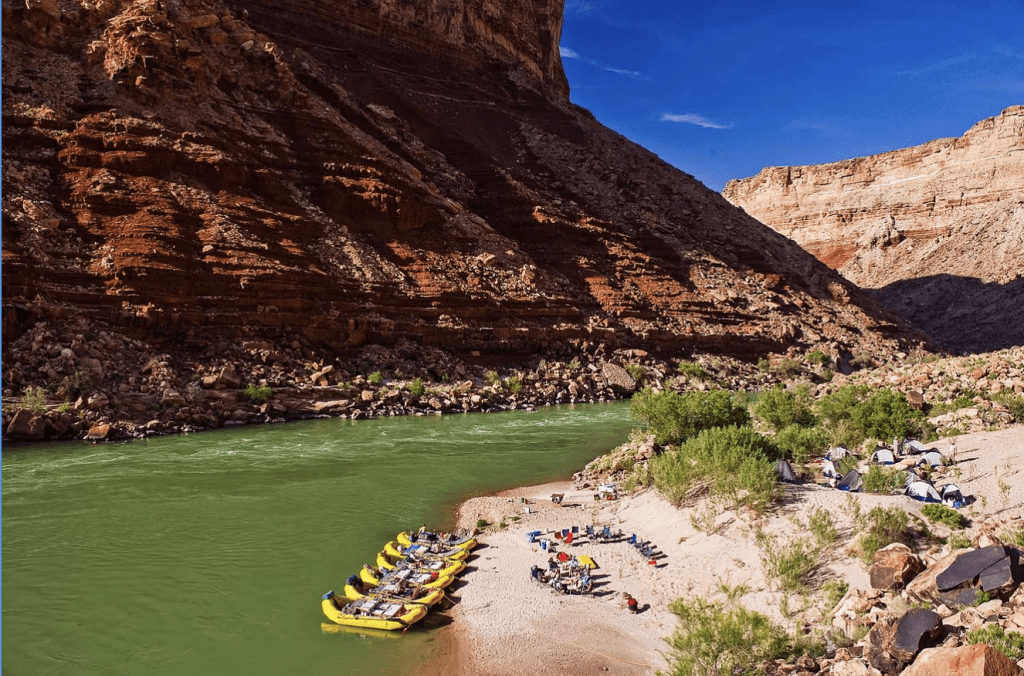
Camp Life
After each active day on the river, we pull ashore to camp for the night. Upon arrival, our first task is to unload the boats using a bag line of crew and passengers to expedite the process. Individuals then collect their waterproof bags and locate an area on the beach to camp for the night. On the first night in camp, a crew member will give a demonstration on setting up a tent, which you’ll see is quick and easy. The guides will set up the kitchen and central dining/seating area with camp chairs. They will also locate a secluded area away from camp to set up the portable toilet, where privacy is assured.
As dinner is being prepared by the guides, hors d’oeuvres will be served, and you will have an opportunity to relax, enjoy a drink if you wish and reflect on the day with your fellow traveling companions.
In the morning, the first wake-up call will let you know that coffee, hot water for tea or cocoa, juice, fresh fruit and cold cereal are ready on the hors d’oeuvres table. You can fill your mug and grab a bite, then begin to pack up your personal belongings and sleep gear as the guides prepare breakfast. After breakfast is served, the entire camp will be broken down, and packing will be completed. The gear will then be loaded onto the boats, and we’ll head downstream to see what new adventures await us.
Meals
The meals we serve are hearty and delicious, complete with fresh ingredients and a variety of foods. A typical morning on a multi-day trip might start with French toast, bacon, fruit, orange juice, and coffee or tea. Lunch might be a delicious spread of cold cuts and cheeses with several types of bread or pitas stuffed with veggies and hummus. There are always cookies and a cooling drink to top it off. At dinner, our guides’ cooking skills truly shine—sizzling steaks or salmon, chicken enchiladas and delicious pasta dishes are all part of their repertoire. Dinner generally includes a salad, and desserts are frequent. Hors d’oeuvres are a pleasant surprise before many meals.
Dietary Restrictions
We need to know as soon as possible about any dietary restrictions we must consider in planning your trip. If you have food allergies or restrictions, we will do our best to accommodate your needs. However, there may be a supplemental menu fee, ranging from $5 – $25 per person per day, to cover any increase in our costs.
Beyond our standard menu, we can provide options for vegetarian, vegan and many allergy-restricted diets without applying a fee. However, we cannot always provide the same diversity or sophistication for restricted diets as we do for our regular menu. Similarly, certain allergen-free snack foods are difficult or impossible to source in our locations, so feel free to bring your own favorite snacks to supplement our provisions. Please let your Adventure Consultant know if you intend to do so.
We cannot guarantee that cross-contamination from allergens will not occur during meal prep, and reserve the right to refuse service to anyone as it relates to safety, including the potential for a medical emergency caused by a severe food allergy. Also, due to the constraints of cooking for a large group in a wilderness setting, availability of ingredients or specialty items in remote locations and limited packing space, we are unable to cater to dietary preferences (likes or dislikes).
Beverages / Alcohol
In camp, we provide sodas, water, coffee and tea. We also carry powdered drink mixes such as Gatorade, Gookinaid or similar to mix in your water bottle. National Park Service regulations prevent us from providing alcoholic beverages to our guests. You are welcome to bring a supply of alcoholic beverages in non-breakable containers, or you can order them using the alcohol order form which will be sent to you with your final invoice.
Please Note: There is no drinking allowed while on the river. Consumption of alcoholic beverages is only allowed while in camp.
Smoking/Vaping
OARS is committed to providing a safe and healthy environment for our guests and for our staff. We ask that smoking of any kind be done away and downwind from other trip participants.
Cannabis
We are obligated to adhere to the regulations established by the managing agency with jurisdiction over the area in which our trip operates. Use of marijuana on federal lands, whether it be medicinal or recreational, is illegal and therefore we ask that you refrain from bringing it with you on your OARS trip.
Drinking Water
Our drinking water comes from the river and is filtered through a purification system we provide. (No iodine is used in the purification process.) We store the purified water in large containers that are accessible in camp, at lunchtime and before hikes for filling personal water bottles.
Fishing
Fishing is an additional activity you can do in camp or when we stop for lunch. The best fishing is on the upper section from Lees Ferry to the confluence of the Little Colorado River where the catch is trout, but you can fish anywhere along the river. The conditions are dependent upon the clarity of the water. You will need to purchase an Arizona state fishing license, which can be purchased online through Arizona Game & Fish at www.azgfd.com. A license can also be purchased in Flagstaff at Wal-Mart. We practice catch and release with artificial lures and flies. You should, therefore de-barb your hooks before you leave home. You’ll need to bring your own gear, and it’s best to have a collapsible pole in a case.
The Portable Toilet
While the idea of a river trip is appealing to most people, many are inhibited or reluctant because of modesty or uncertainty. To minimize our impact, we carry out all solid human waste and use a portable toilet system that is set up each day at camp in a secluded location a discrete distance from tent sites. It is essentially a toilet without plumbing and is available from the time you pull into camp each afternoon until you leave camp the next day. Toilet paper and a convenient hand-washing station are provided.
We also carry a small container called the “day tripper” that can be easily accessed during the day should the need arise. It is a personal disposable toilet, which includes an odor-proof transport bag, chemical solidifier and odor eliminator, toilet paper and oversized hand wipe. On popular stretches of wilderness rivers, the common refrain is “dilution is the solution to pollution.” We practice this approach by urinating in the river during the day. For use in camp at night we provide pee buckets so that urination can occur in a secluded location and then be dumped into the current where it will be carried downstream.
Bathing
Bathing is only allowed in the river but is definitively not allowed in any of the side streams that feed into the river. If you plan to bring soap, we recommend using a liquid biodegradable soap such as Campsuds or Dr Bronner’s (www.drbronner.com), which can be purchased in most stores that have a camping section. Disposable anti-bacterial towelettes (Coleman Swash Cloths, baby wipes, etc.) are good alternatives to submersion in the river and are especially convenient for spring and fall trips.
Foot Care
Good foot care is a must. You should have footwear that is comfortable and well broken-in, but is newer and will not fall apart. Closed-toe shoes are the best protection for hikes. Avoid sunburn and try and keep your feet out of the water. Keep your toenails trimmed. After a day on the river, wash your feet with soap, moisturize and put on clean, dry socks and shoes. Always wear shoes, even in camp. If you experience any foot care problems, ask your guides for assistance.
Skin Care
It’s very important to take care of your skin while on your Grand Canyon trip. The combination of sun, sand, water and wind quickly causes extreme dryness, which can then lead to cracked skin. Once your skin cracks, it will have a hard time healing until you return home. Hands and feet tend to take the greatest beating and therefore, should be given the most attention. When you arrive in camp each afternoon, it is a good idea to bathe and moisturize your skin with a heavy-duty moisturizer. Put on clean, dry shoes to give your feet a break from the elements. Some people also like to apply moisturizer to their feet and hands before bedtime and then cover them with socks and/or gloves. Each morning before leaving camp, apply plenty of sunscreens and remember to reapply during the day. By drinking plenty of water and staying well hydrated, you can also help prevent your skin from cracking.
For Women Only
Even if you aren’t anticipating your menstrual period, come prepared for it. You can use sandwich-sized Ziploc baggies during the day to store feminine products while you are on the river or hiking, and you can then discretely dispose of the baggies when you reach camp. When possible, we recommend o.b.® tampons, which are 1/3 the size of regular tampons, tuck discreetly into pockets and have less paper wrapping. If you use pads, be sure to bring extras. Many women suggest bringing a small supply of baby wipes. We provide some feminine products on most trips for emergencies.
Cameras
We provide a small waterproof bag (17” tall x 9” diameter—approximate sealed size) to hold your camera and other items you might need during the day. While these bags are designed to be waterproof, you may wish to place your camera in a zip-lock plastic bag or waterproof casing for additional protection. We also strongly recommend you take out a rider on your homeowner’s policy to cover your camera—especially if it’s fine equipment. Make sure to bring additional memory cards, batteries and any other extras you will need. Disposable waterproof and panorama cameras are also a fun option.
Electronics & Technology
The use of electronic devices, especially music players and flying drones, on your trip may represent an intrusion into the wilderness experience of your fellow guests. We ask that you please be mindful of the impacts on others and respect the wilderness nature of the trip. Please bring headphones if you intend to listen to music during the trip and leave your drone at home*.
Many of our guests travel with their smartphone even though there is no cell service. On a trip like this, there is always the risk of water damage to smartphones and other electronic devices, even when they are stowed in a dry bag. If you intend to take your phone with you on the river, consider investing in a small, waterproof container just for your phone.
*The use of drones is prohibited by the National Park Service in the Grand Canyon.
Power Sources
We are not able to provide a power source for recharging devices. To keep cameras, phones, GPS and other devices working, you may need spare batteries or portable power. Options include compact portable solar panels that can recharge devices directly, portable power banks that store power, or a combo unit that can be charged before the trip and recharged with a built-in solar panel.
Communication
Once you are on the river, there is limited communication with the “outside world.” Cell phone service is not available. Our guides carry satellite phones which are strictly used to call out in case of an emergency situation on the river. They can call out, but we cannot call them. Periodically the trip leader will check in with our office. If you have someone that needs to contact you about an emergency at home, they should call our office (800-346-6277). If possible, we will relay the message to you. Keep in mind. However, it could be several days or longer before the message actually reaches you. For your family at home you should define for them what you consider an emergency and provide them with instructions to call our office in the event one occurs during your vacation.
Firearms
Our guides do not carry firearms on our trips, and in most cases are prohibited from doing so by the managing agency. As a matter of preference, we ask all our guests to kindly leave your own firearms at home or in your vehicle.
Traveling at High Altitude
Flagstaff and the highest point of the South Rim are about 7000 feet/2,135 m above sea level, therefore you may experience symptoms associated with altitude illness. We recommend the following measures to help prevent altitude illness: arrive ahead of your scheduled departure to allow for acclimatization; drink 3-4 quarts of water every day; make sure about 70% of your calories come from carbs; only use alcohol, tobacco or sleeping aid medications in moderation or not all. Please familiarize yourself with symptoms, treatment and more about altitude illness at the CDC.
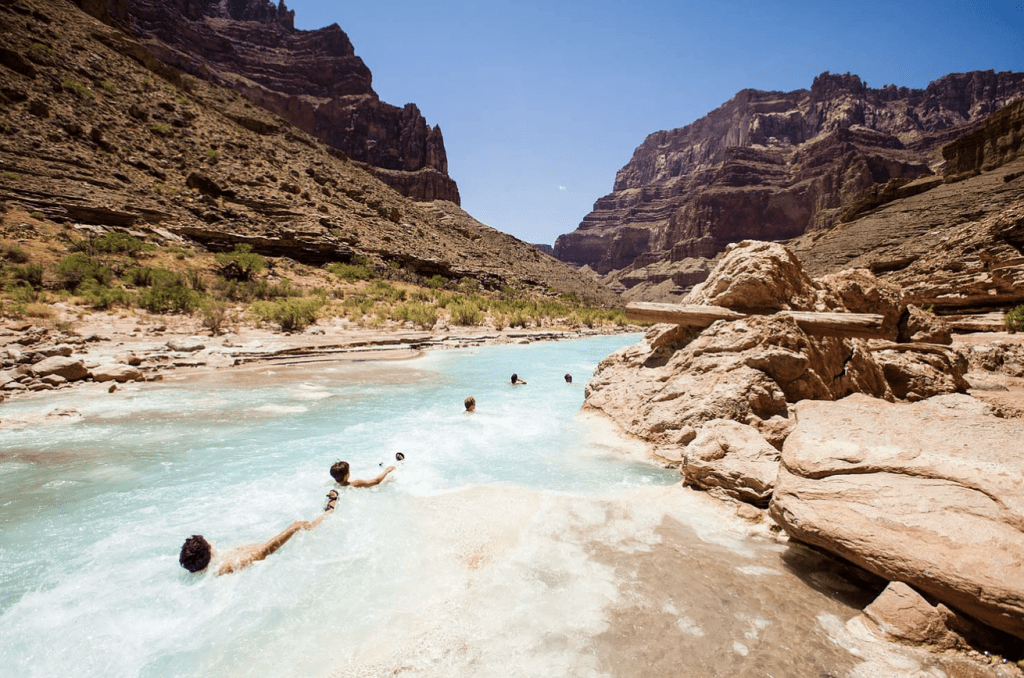
WEATHER & WATER CONDITIONS
In the desert climate of the Grand Canyon, temperatures and weather can fluctuate a great deal throughout the day. It can be clear, dry and hot and in the next moment it can be cool and rainy. These conditions can manifest in any month. There are no absolutes when talking about weather in the canyon. The descriptions and chart below lists average weather conditions, maximum and minimum temperatures and average rainfall. This chart should be used only as a general guide. Packing according to the list will prepare you for all weather conditions.
April: April is less crowded in the canyon and is an excellent time to view cactus in bloom. The days are shorter with a chance of possible storms, but at night you can sit around the campfire (April & October only).
May: A favorite time for people to visit, but also one of the most crowded. The weather is moderate and consistent, but can be windy at times. The water is very often clear from mid to late May.
June: Early June has hot days and mild nights. Temperatures increase with each day into the month. A very busy time to be in the canyon.
July: Very hot with the chance of some early monsoons, which are more prevalent in August. Any and all weather can be experienced at this time. When rain showers do materialize the afternoons are generally cooler.
August: Traditionally this time of year is the monsoon season with clouds building up early in the day, releasing with heavy short bursts in the afternoon, and often clearing by evening. The clouds and showers help lower the extreme temperatures.
September: Moderate temperatures cooling as the month progresses. The days are mild with cool nights. There is less traffic in the canyon since September 15 is the last launch date for motorized trips.
October: Can be very nice, but always presents a possibility of storms. Need to be prepared for changes in weather conditions. Nice temperatures for side hikes and opportunities to sit around the campfires at night (April & October only).
Summer Temperatures (June, July & August): Please note that the average summer temperatures listed can be misleading. These temperatures are recorded in very specific locations and circumstances. In the summer it is not uncommon for the temperature to rise above 110° F. At the same time, temperatures can suddenly plummet with increased cloud cover. The advice is to always be prepared with rain gear and clothing that can be layered.
Temperature at the Rim: The temperature at the rim is generally 20-30 degrees cooler then along the river since the South Rim is around 7000’ in elevation. Keep this in mind especially if you are on an early spring or late fall trip.
Contact Traveluxe Official to book this amazing experience!
Source: OARS

Emily Lockard-Furry began selling travel in 2014. She specializes in destination weddings and honeymoons, but also plans itineraries for multi-generational families and incentive reward travel.

